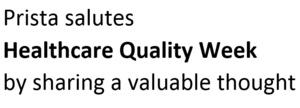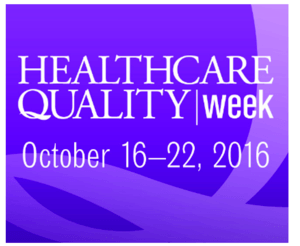Category Archives for Industry News
National Healthcare Quality Week
As a contribution to the celebration of all of those who work diligently and passionately in Healthcare Quality, we would like to plant a seed of thought, an innovative vision, of pursuing the goals of Quality (and its intimate partner, Safety) to get better outcomes, more consistently, while using less effort and cost, and feeling less frustration. In other words, an easier path to improvement.Historically, “Quality” has been tightly associated with “reporting” and it may be understandably difficult for many to separate their thinking in that regard from the collection and manipulation of data, research on and calculation of Performance Measures, visual analysis of number grids and graphs, generating and compiling reports, and sitting though hours of review meetings to share and discuss the information. And much of the effort in Quality reporting targets higher level management and especially external parties, rather than the clinical staff themselves. Many describe such responsibilities as overly mechanical and time-consuming, seriously reducing the time and brain power left over for the cognitive work of imagining, planning and confirming improvement in healthcare delivery. Even highly-respected overt methodologies, which supposedly serve that improvement goal, often add to the mechanical effort requiring procedural education, special forms, jargon, and more meetings.To a great degree, much of that is accepted, personally and organizationally, as being “the Quality job”, but perhaps there is vision of something different. A breakthrough.
The reason we talk about a breakthrough is important. There is a very strong tendency, while trying to improve processes, to simple tweak the same activities and artifacts that have been part of the process for a long time. That is definitely the case with quality. If we focus on the cognitive path, from observation to improvement, and design optimally for the digital/electronic medium to support that, then real progress can be made. This must not be equated to having users take on the mindset, language or skills of “techies”. It should be the case that the power of technology and especially the design expertise that is coupled to it, is delivered into the operative “space” of the targeted users.
When that is done well, much of the mechanics, physical activities and artifacts can be eliminated and the most precious resource of the clinical staff – their professional intellectual capabilities – are channeled toward the improvement goal. To put that in tangible terms, this vision is about one place where all the information involved in the Performance Measures of Quality Management, in Safety Event reporting and investigation, and in the Action Plans for Performance Improvement exist in intuitive, connected, workflows. The net effect is a design that radically reduces both labor and mental exertion to get actionable insights.
Realizing such a vision may be challenging because of departmental, process, policy and political barriers, the natural inhibitors of fear, ego and comfort, and the tyranny of time and money invested in the “old ways”. But why should you or your organization let those stand in the way of your passion to pursue Quality the way you’ve always known it should be done?
Alliance with CIHQ
Prista Corporation and the Center for Improvement in Healthcare Quality (CIHQ) Collaborate to Enhance Patient Safety

About the Collaboration
Prista and CIHQ are driving for the same goal – to radically improve the effectiveness and efficiency of quality-safety* efforts in healthcare delivery organizations. While the organizations differ in services and approach, their philosophies related to providing education, resources and tools to the healthcare community are well aligned.
Through a variety of communication vehicles, CIHQ provides education, shares perspectives on patient safety and compliance, and presents available resources and tools. Through its ActionCue Clinical Intelligence online application, Prista enables subscribers to significantly reduce and streamline the mechanics and manual data manipulation of the improvement processes for quality-safety.
Billie Anne Schoppman, Chief Mission Officer at Prista reflects “CIHQ is innovative, nimble and responsive just like Prista and makes a great partner to really help care providers break through some stasis and inertia to put best practices to work and drive quality and safety improvement like never before – effectively, efficiently and consistently.”
Rick Curtis, Chief Executive Officer of CIHQ, explains his perspective; “We’re excited to partner with Prista. Both our organizations share a common Mission and purpose. Our partnership will enable Prista clients to access our vast array of web-based support services, and our clients will benefit from access to Prista’s innovative quality and patient safety management platform. It’s not just a win/win for both companies, it’s a win/win for our respective clients.”
Be on the lookout for lots of content and opportunities to participate in demonstrations to learn how Prista’s ActionCue platform and CIHQ’s education, advice and content go hand-in-hand to advance our joint subscribers and members to the forefront of America’s healthcare organizations.
* – Quality-safety reflects Prista’s position that care quality and safety for patients are inseparable and should naturally be addressed together in an integrated improvement–centered management process.

About CIHQ
The Center for Improvement in Healthcare Quality (CIHQ) is a membership-based organization comprised of over 300 acute care and critical access hospitals across the United States. Member organizations enjoy a comprehensive program of web-based and other support services designed to help them be successful in their accreditation and certification compliance efforts. CIHQ is also recognized as a deeming-authority by CMS for acute care and long-term acute care hospitals.
About Prista
Prista provides the ActionCue® Clinical Intelligence online application, a very innovative platform integrating Quality Management, Event Reporting and Investigation, and Performance Improvement functionality. Beyond a dashboard or reporting tool, ActionCue provides a complete work environment for staff, management and executives to obtain immediate insights into all clinical issues and what is being done to improve them, to own and drive the improvement-centered quality-safety process as never before.
Top Healthcare Quality Issues of 2015
Source: HealthLeadersMedia.com
Six quality issues warrant the attention of healthcare leaders: misdiagnoses, star ratings, socioeconomic adjustment for readmissions, the end of Partnership for Patients programs, Medicaid parity expiration, and Disproportionate Share Hospital cuts.
Healthcare has experienced fascinating changes during the last few years, and 2015 will be no exception.
Major programs stemming from the Patient Protection and Affordable Care Act are well under way, dozens of new quality measures and data galore are flowing into the public domain, and quality of care remains in the spotlight for providers at all levels.
There are sure to be tweaks, especially where measures and performance commingle to affect payment. But here are six quality issues that warrant your attention in 2015.
1) Measuring misdiagnosis
If physicians’ diagnostic accuracy were like air travel, one in 20 planes would not land when or where it should, and one in 40 flights would put passengers at risk of significant harm, or even crash.
Those are estimations from an April 2014 report from Houston Veterans Affairs and Baylor College of Medicine researcher Hardeep Singh, MD, and colleagues who say that 12 million U.S. outpatient adults may be given incorrect or delayed diagnoses every year.
Singh says reducing misdiagnosis must be a major quality focus for 2015 because providers and patients should not tolerate error rates this high.
Singh’s report in BMJ Quality & Safety estimated that 5.08% of outpatients receive an inaccurate diagnosis, and that half of those errors have the potential to cause severe patient harm, such as a missed opportunity to treat cancer at an earlier, easier stage. These misdiagnoses can result in avoidable or extended hospitalizations or even death.
Though misdiagnoses may be a patient safety issue on a par with medication errors or infections, providers don’t measure or track them. It can be hard to assign blame: sometimes patients don’t know or fail to reveal relevant details. But sometimes the fault is the provider’s, for failing to take an adequate history or conduct a proper physical exam.
…Story continued on original site.
Looking for ways to make your Risk/Quality Management job easier?
How would you like your hospital to have a ‘Culture of Quality’?
Save up to 30% on your RM/QI & PI programs.
U.S. Boosts New Ebola Drug
The U.S. government says it will help develop a new Ebola drug — one of five drugs that are being tested against the deadly virus. This one’s made by North Carolina-based BioCryst Pharmaceuticals.
“BioCryst’s drug, BCX4430, is a small molecule that prevents the Ebola virus from reproducing in the body,” the Health and Human Services Department said in a statement. “Small molecule” means it can be taken as a pill.
“In non-human primate studies, the drug was effective against Ebola virus and Marburg virus, another virus in the filovirus family, indicating that BCX4430 may be useful as a broad spectrum antiviral drug.”
It’s being developed alongside ZMapp, Mapp Biopharmaceuticals’ antibody-based treatment; Canadian company Tekmira’s drug that interferes with genetic material; an antiviral called favipiravir and blood-based treatments using plasma from Ebola survivors.
Makers of a pill called brincidofovir have stopped testing it.
“We are making progress quickly to develop product candidates for clinical evaluation and to make products available that protect against this virus,” said Robin Robinson, who directs HHS’s Biomedical Advanced Research and Development Authority.
More than 25,000 people have been infected with Ebola, according to the latest report from the World Health Organization, and more than 10,000 deaths have been recorded, although at least half and likely more of the patients have died, WHO says.
Officials say as long as Ebola is circulating, people can bring it to the United States. An American with Ebola is listed in fair condition at the U.S. National Institutes of Health. That patient and another 16 Americans were evacuated from Sierra Leone earlier this month.
On Tuesday, the University of Nebraska said five of the people quarantined there have been released after showing no signs of Ebola for 21 days.
…Story Continued On Original Site
Looking for ways to make your Risk/Quality Management job easier?
How would you like your hospital to have a ‘Culture of Quality’?
Save up to 30% on your RM/QI & PI programs.
How Cloud Computing Enables Interoperability
CMS has signaled a renewed focus on interoperability, a welcome development for healthcare professionals anxious to more easily exchange insightful data. But there’s still the matter of how well the people involved in various collaborative “Big Data in Healthcare” initiatives operate together.
At some point for most of us in our careers – usually early on – we’ve encountered a project that was initially heralded with a great deal of fanfare, only to ultimately fizzle out after failing to gain enough buy-in. For all the excitement surrounding Big Data projects, many are at similar risk of a premature end if stakeholder concerns aren’t addressed at the outset:
- Who will host the data?
- How will data privacy concerns be handled?
- How have restrictions on data use been addressed?
- Do existing consents allow for data sharing?
- Will the data need to be de-identified? If so, using which methodology?
- Who will be responsible for acquiring, maintaining and distributing it?
- How will the data be protected as it’s routed to its new home?
- How well will it be protected in its new home? Who will have access to it?
For this to work, a neutral ground is usually needed, offered by a trusted third party.
The cloud: breaking down barriers to data exchange
In healthcare, massive amounts of data are not stored in pre-defined, structured tables. Instead, they are often composed of text, notes, numbers, images, formulas, dates, and other facts that are inherently unstructured. In fact, certain kinds of data sources are being created so quickly that there is no time to store it before the need to analyze it.
Savvy healthcare executives see Big Data as an opportunity to break down the paradigm of siloed data. They know that isolated data can be inefficient. Yet even while supporting the vision of Big Data, many healthcare leaders are traditionally reluctant to share data outside their own firewalls. Due to competitive considerations and confidentiality risks, there must be a level of trust in the quality and security of the receiving organization’s health data management systems for the data owner to be willing to share it. No one wants to risk a HIPAA privacy or security violation at the hands of another entity.
‘Dirty’ data can yield hidden treasures
To make an effective Big Data play, data sharing arrangements must be made, data flows defined, data analytics engines and the underlying infrastructure created, and the proper data governance must be agreed upon by all relevant stakeholders. It is at this stage that a trusted third party data warehouse environment is critical for success.
…Story Continued On Original Site
Looking for ways to make your Risk/Quality Management job easier?
How would you like your hospital to have a ‘Culture of Quality’?
Save up to 30% on your RM/QI & PI programs.



